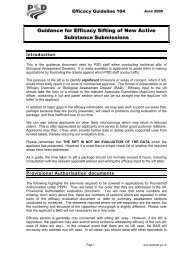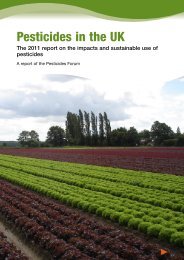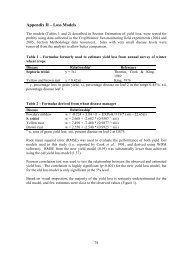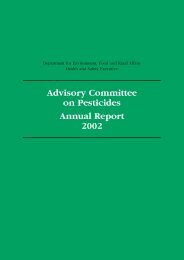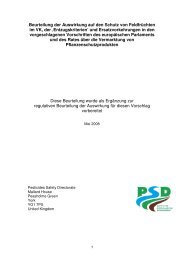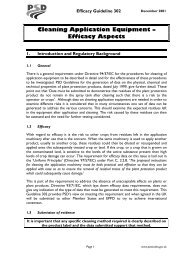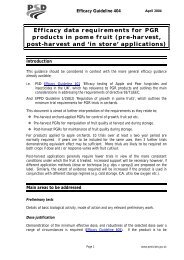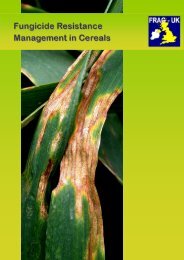Advisory Committee on Pesticides Annual Report 2001
ACP Annual Report 2001 - Pesticides Safety Directorate
ACP Annual Report 2001 - Pesticides Safety Directorate
You also want an ePaper? Increase the reach of your titles
YUMPU automatically turns print PDFs into web optimized ePapers that Google loves.
Secti<strong>on</strong> F: Other items c<strong>on</strong>sidered during the year<br />
The questi<strong>on</strong>naire showed that 72 percent of all holdings c<strong>on</strong>tacted stored<br />
grain and 51 percent used pesticides either as fabric treatments or admixture<br />
treatments. Those holdings in the South Western and Midlands and Western<br />
regi<strong>on</strong>s were more likely to be applying fabric treatments, while the<br />
applicati<strong>on</strong> of both fabric and admixture treatments was more prevalent<br />
in the South Eastern regi<strong>on</strong>.<br />
Almost 16 t<strong>on</strong>nes of pesticides were applied in farm grain stores in Great<br />
Britain with Eastern regi<strong>on</strong> accounting for 29 percent of the total weight<br />
applied, South Eastern 25 percent, Midlands and Western 19 percent and<br />
South Western 14 percent.<br />
By weight 54 percent of pesticides were applied as fabric treatments, with<br />
pirimiphos-methyl accounting for 88 percent of all fabric treatments. The<br />
remaining 46 percent of pesticides were applied to the grain either at or<br />
during storage. Of all grain treated, 57 percent by weight was treated with<br />
an admixture, the rest receiving surface treatments. Pirimiphos-methyl<br />
accounted for 78 percent of the weight of pesticide applied, either as<br />
admixture treatments or incorporated into the surface of the grain in store.<br />
C<strong>on</strong>tractors applied 14 percent, by weight applied, of fabric treatments but<br />
<strong>on</strong>ly seven percent of the admixture treatments. C<strong>on</strong>tractors made all<br />
applicati<strong>on</strong>s of aluminium phosphide recorded in this survey.<br />
73<br />
Since the survey c<strong>on</strong>ducted in 1994/95 there had been a two percent increase<br />
in the t<strong>on</strong>nage of grain stored, with the weight of active substances applied<br />
having increased by less than <strong>on</strong>e percent. There has been a decrease in the<br />
number of active substances applied to grain. Organophosphates c<strong>on</strong>tinued to<br />
account for the majority of pesticides used in grain stores and in the current<br />
survey they accounted for 97 percent of the total weight of pesticides applied.<br />
<strong>Report</strong> 180: Commercial grain stores in Great Britain 1998/1999<br />
This report presented data from 210 replies from a preliminary questi<strong>on</strong>naire<br />
sent to 283 potential commercial grain stores and the results from visits to<br />
143 premises storing grain from the 1998 harvest in Great Britain and using<br />
pesticides. Data had been extrapolated to give nati<strong>on</strong>al estimates of usage<br />
in Great Britain.<br />
A total of 8.3 milli<strong>on</strong> t<strong>on</strong>nes of grain was stored of which 52 percent was<br />
in upright stores. The questi<strong>on</strong>naire showed that 94 percent of all premises<br />
c<strong>on</strong>tacted stored grain and 88 percent used pesticides either as fabric<br />
treatments or grain treatments. Stores in Scotland and South Eastern regi<strong>on</strong>




